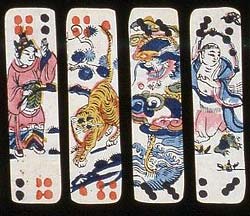Sometime in the late eighteenth to early nineteenth century, a game called ma jiang was developed. The game is played with tiles, normally about 140 tiles for four players. The tiles are distributed to the players, and the aim of the game is to create sets by discarding and picking the appropriate tiles. Dice also are employed, but their use is limited to determining where the tiles are first drawn. This game would become the first consciously “Chinese” game popularized in the West as mahjong.
Another tile game that has remained popular is dominos. The earliest domino sets contained thirty-two pieces, and this has been the favored combination ever since, used for playing games like tian jiu (literally, heaven nine) or pai jiu (literally, domino nine). Later, larger sets were put together based on the twenty-one different dominoes in this thirty-two-piece set.
The remarkable range of Chinese card games include poetry tiles, drinking card games, erotic cards, chess (xiangqi) cards, numbers cards, The Three Characters Classic cards, and specific card games invented by literati that may not have had a wide following. Surprisingly, cards were not used for fortune telling, as they were in the West, although the thirty-two-piece domino set was used for this purpose.






